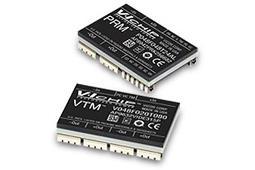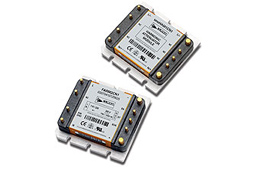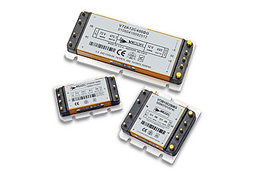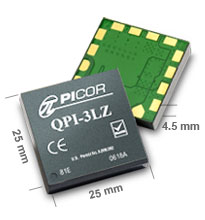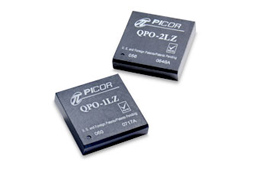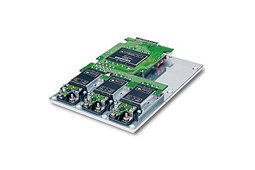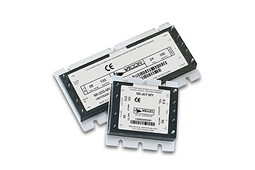Successful Applications
V•I Chips Power Wing De-Icer
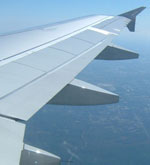 It is an inescapable fact that, whenever aircraft operate where freezing temperatures and precipitation are present, important sensors and surfaces must be kept free of ice. Most travelers in cold climates have observed the de-icing process as ground crews spray these sensors and surfaces before takeoff. It is also crucial that the aircraft employ an in-flight system to keep ice from forming. Various systems have been used such as anti-freeze pumped through holes to reach the critical surfaces. One interesting scheme for dealing with ice in flight is the use of „pneumatic de-icing boots,“ which are inflatable rubber coverings that are periodically inflated to crack the ice, which is then blown away. Electrical heating elements are also often used to prevent the formation of ice.
It is an inescapable fact that, whenever aircraft operate where freezing temperatures and precipitation are present, important sensors and surfaces must be kept free of ice. Most travelers in cold climates have observed the de-icing process as ground crews spray these sensors and surfaces before takeoff. It is also crucial that the aircraft employ an in-flight system to keep ice from forming. Various systems have been used such as anti-freeze pumped through holes to reach the critical surfaces. One interesting scheme for dealing with ice in flight is the use of „pneumatic de-icing boots,“ which are inflatable rubber coverings that are periodically inflated to crack the ice, which is then blown away. Electrical heating elements are also often used to prevent the formation of ice.
A manufacturer of aircraft systems selected Vicor V•I Chips to power their electrical de-icing system. The application uses two MIL-COTS VTMs and two PRMs per wing, providing dual redundancy. The MIL-COTS PRM operates from a wide input range of 16 – 50 Vdc, meeting many of the airborne requirements of MIL-STD-1275 and MIL-STD-704. Rated for 120 W, the 28 V PRM produces a nominal factorized bus voltage of 36 Vdc, controllable over the range of 26 – 50 Vdc. The downstream isolated VTM is available with twelve voltage division ratios from 1:1 to 1:32 and provides the user with flexibility to supply up to 100 A or 120 W at any output voltage from 1 to 50 Vdc in a surface-mount package occupying only 1 square inch.
The V·I Chip-based power design significantly enhances the test equipment’s sales features. The new equipment has twice the number of test channels of its predecessor and features additional architectural improvements.
Battery-Controlled Electrical Propulsion Enables Long-Range, Multi-Lap Glider Flights
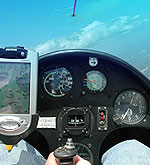 Conventionally, gliders are taken by a tow plane to an altitude sufficient to increase the pilot’s likelihood of finding thermals to prolong their flight time after release. Auxiliary propulsion systems have been used to extend their range and flexibility, even to take off in the first place. Combustion motors have proved unsatisfactory for this application, but an electrical system has been successful.
Conventionally, gliders are taken by a tow plane to an altitude sufficient to increase the pilot’s likelihood of finding thermals to prolong their flight time after release. Auxiliary propulsion systems have been used to extend their range and flexibility, even to take off in the first place. Combustion motors have proved unsatisfactory for this application, but an electrical system has been successful.
The glider uses Li-ion cells to provide enough power for five minutes of operation or to climb to the desired altitude. Integral to the design of this propulsion system is the inclusion of battery charging system inside the glider enabling it to make long distance multi-lap flights and be recharged at any airfield.
Featuring high efficiency and low weight, Vicor DC-DC converters are the heart of the charging system. The charging system has a front end and a power section housed in two separate cabinets mounted in the glider fuselage. The front end consists of three ENMod AC front ends while the power section uses eight Vicor Mini DC-DC converters. The power section is connected to the battery array, which is installed inside the wings. The resulting charging unit weighs only 6 kg (about 1pounds) including cabling. The unit consumes approximately 1.7 kW of mains power and requires just nine hours to fully recharge the glider’s batteries. The auto-ranging front end of the charger is compatible with voltages from 110 to 230 Vac, making it usable worldwide.
Superior EMI / EMC Filtering for Flight Instrumentation
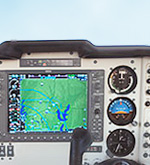 A flight management system (FMS) is a fundamental part of a modern aircraft.
A flight management system (FMS) is a fundamental part of a modern aircraft.
It controls the navigation, holds the flight plan, and logs important data needed to ensure the scheduling of routine maintenance. It uses various sensors and global positioning equipment to determine the position, altitude and speed of the aircraft, and given the position and the flight plan, the FMS also helps guide the aircraft to the desired destination. The FMS is normally controlled through a small on-board computer which will output a display of the electronic flight instrument system. The modern FMS was introduced on the Boeing 767, though earlier navigation computers did exist. Now, they can be found on aircraft as small as the Cessna 172.
Flight management systems and other peripheral devices such as radar, terrain awareness, and data loggers, typically need to be able to operate from a noisy 24 Vdc voltage source that has been down-converted from the AC that is generated by the plane’s engines. A typical FMS device often has low steady state current requirements, at 7 A or less, but could have peak requirements up to 10 A or more. For these applications Picor’s QPI Active input filters can filter the EMI and support requirements up to 14 A.
In addition to aircraft EMI requirements, cockpit displays may require a low ripple power source, with noise levels <10 mV p-p. Power to displays is less than 30 V, and current levels can be as high as 10 A. Picor QPO and uRAM active ripple attenuators can support requirements up to 30 A.
Since cockpit space is tight and low-noise performance is critical, active filters provide unique value by combining superior noise attenuation and a compact package size. Both the QPI input filters and QPO output ripple attenuators come in a standard
25 mm x 25 mm x 12.5 mm low-profile LGA package.
Helicopter Display Upgrade Squeezed Space and Increased Number of Voltages
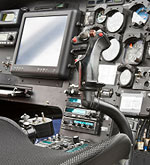 Upgrading displays in helicopters from large, bulky CRTs (Cathode Ray Tubes) to LCDs (Liquid Crystal Displays) significantly disrupted the power supplies for this application Helicopters generally provide a single supply voltage of 28 V. The new LCD designs needed a complex mixture of voltages and control frequencies to generate the display and provide illumination through a fluorescent or LED (Light Emitting Diode) backlight. As customers demand the integration of compute functions into the monitors, the ability to support a complex mixture of output voltages will become even more important.
Upgrading displays in helicopters from large, bulky CRTs (Cathode Ray Tubes) to LCDs (Liquid Crystal Displays) significantly disrupted the power supplies for this application Helicopters generally provide a single supply voltage of 28 V. The new LCD designs needed a complex mixture of voltages and control frequencies to generate the display and provide illumination through a fluorescent or LED (Light Emitting Diode) backlight. As customers demand the integration of compute functions into the monitors, the ability to support a complex mixture of output voltages will become even more important.
Vicor converters are designed to be user-customized. Almost any combination of input and output voltage and power is available on each module. This reduced the need to mix and match multiple off-the-shelf modules within the system; it also helped to save space.
Customization was made easy by using the Vicor PowerBench™ on-line tool suite, which enabled the design of customized bricks to their exact specifications in minutes. The system enabled design engineers to specify and check the configuration of its Maxi, Mini, Micro DC-DC converters. A Vicor distributor with extensive design-in capabilities used PowerBench to come up with tuned designs for this customer’s latest generation of products.
Further space savings were possible through the DC-DC converters‘ use of high frequency zero-current switching and zero-voltage switching, These techniques, coupled with advanced power semiconductor packaging, provide high density with low temperature gradients. These designs tripled power density compared with previous DC-DC converters, vital for the designs in the space-constrained aerospace sector.
Picor Active Filters Overcome Space and EMI Challenges for Helicopter Displays
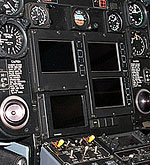 Designers are replacing bulky cathode-ray tube (CRT) helicopter displays with much thinner and space-efficient liquid crystal displays (LCDs). For new applications, some are specifying LCDs as small as 2.5 in across to make the most of the cockpit space. These changes make new demands on power and the need to manage EMI (electromagnetic interference).
Designers are replacing bulky cathode-ray tube (CRT) helicopter displays with much thinner and space-efficient liquid crystal displays (LCDs). For new applications, some are specifying LCDs as small as 2.5 in across to make the most of the cockpit space. These changes make new demands on power and the need to manage EMI (electromagnetic interference).
In this context, designers of helicopter displays were faced with the dual challenge of squeezing as much functionality as possible into a small space as well as dealing with the electromagnetic interference (EMI) from systems that operate at increasing frequencies. The small space constraints made it difficult to use conventional passive shielding techniques, which are often bulky.
Picor active EMI filters, however, met the stringent requirements of, for one example, the US Department of Defense DO160 standard and provided higher attenuation than passive filters in a much smaller space. Picor’s QPO-1 active filters provide output ripple and noise attenuation of more than 30 dB from 1 kHz to 500 kHz and more than 20 dB in the 50 Hz to 500 Hz range. A single module replaces at least five bulky passive components and provides better results.
Able to support load currents up to 10 A, the tiny filter module can handle a wide voltage range from 3 V to 30 V DC. As well as providing better noise attenuation than a bulky network of external passive components, the QPO-1’s closed-loop architecture improves transient response – vital for modern embedded computers and displays – and ensures quiet point-of-load attenuation.
EMS Provider Upgrades Aircraft Intercom System with VIPAC
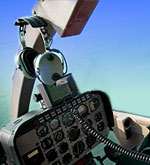 Gigantic Defense Department budgets are essential to develop the latest and greatest military systems – armored vehicles, fighter aircraft, warships – to maintain supremacy in a dangerous world. At least, that’s the perception of many. In fact, however, the military is more likely to continue maintaining and using its major systems long after a comparable commercial system would have been replaced. A couple of good examples are the C-130 military transport and the B-52 strategic bomber. Both have been in continuous operation for over 50 years. Of course, maintenance and upgrades of their numerous systems and subsystems occupy armies of suppliers continuously as long as these aircraft – or any other major military asset – are in service.
Gigantic Defense Department budgets are essential to develop the latest and greatest military systems – armored vehicles, fighter aircraft, warships – to maintain supremacy in a dangerous world. At least, that’s the perception of many. In fact, however, the military is more likely to continue maintaining and using its major systems long after a comparable commercial system would have been replaced. A couple of good examples are the C-130 military transport and the B-52 strategic bomber. Both have been in continuous operation for over 50 years. Of course, maintenance and upgrades of their numerous systems and subsystems occupy armies of suppliers continuously as long as these aircraft – or any other major military asset – are in service.
Much of this maintenance and upgrade work – including even such necessary tasks as return/repair services – is done by contract manufacturers rather than the original equipment manufacturer (OEM), especially since the emergence of outsourcing. While the OEM may still be in the loop, subcontracting enables them to focus on their current business. A leading EMS (electronic manufacturing services) provider that offers services from product design through manufacturing included a Vicor power supply in a product upgrade.
The application was an intercom system retrofit for older military aircraft. The original intercoms had limited functionality and low voice quality because of the simple electronics. Current headset quality has also improved substantially since the original. The power supply being used is a VIPAC AC-DC configurable power supply with a 115 Vac input at 400 Hz, with two 39 V outputs (two 36 V Minis trimmed up to 39 V). The system incorporates a low-noise, autoranging FARM modular front end that provides EMI filtering, transient protection, and inrush current limiting.
Airborne Surveillance Radar Redesign Uses MI-J00 Converters
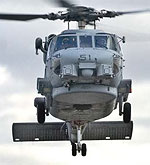 A broadly-based major manufacturer of electronic systems offers advanced radar and communication systems for worldwide aerospace, defense, and commercial markets. Their radar systems division manufactures land based, seaborne, and airborne surveillance radars, mostly for complex and critical applications.
A broadly-based major manufacturer of electronic systems offers advanced radar and communication systems for worldwide aerospace, defense, and commercial markets. Their radar systems division manufactures land based, seaborne, and airborne surveillance radars, mostly for complex and critical applications.
One class of radar, designed to operate in manned or unmanned helicopters or fixed-wing aircraft, is designed for search, surveillance, detection and tracking, and other critical missions over water. These missions include search and rescue as well as patrols to detect contraband or illegal immigration, performed under all weather conditions, day and night. These radars, and consequently the power supplies, must be small, light, rugged, and reliable to withstand such long and demanding missions.
Redesign of a multi-mode airborne radar system involved a change not only in the power supplies, but a switch from third-party vendor to an in-house design based on Vicor DC-DC modules and input attenuator modules.
The small size and rugged construction of the M-J00 converters were especially appealing to the designer for this application. The input voltage for this design was 28 volts with multiple output voltages; most of them relatively low power. The outputs were: +20 V at 0.5 A; -20 V at 0.5 A; +15 V at 0.3 A; and +5 V at 8 A. The output voltage can be externally trimmed or programmed from 50% to 110% of nominal output.
The specified MI-J00 DC-DC converter is, of course, fully encapsulated, meets MIL-STD- 810 environmental testing requirements for humidity, fungus, salt-fog, explosive atmosphere, acceleration, vibration, and shock.
Vicor Bricks Power Passenger In-Flight Internet on Commercial Airlines
First demonstrated early in this decade, in-flight Internet for use by passengers on commercial airliners is only now becoming a practical reality. Early systems were large and heavy, limiting their use to large jet 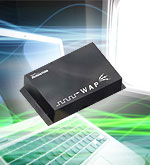 carriers with dual aisles. Those that relied exclusively on satellite technology were subjected to the uncertainties of receiving a signal. Most of the systems were, in addition, used expensive.
carriers with dual aisles. Those that relied exclusively on satellite technology were subjected to the uncertainties of receiving a signal. Most of the systems were, in addition, used expensive.
In-flight wireless Internet service is now providing airlines with a new revenue stream. The leading system uses proven wireless technologies that are lower in cost than competing approaches, while avoiding the need for larger and heavier onboard equipment. The critical avionics hardware is contained in two packages ― one of which includes the power supply ― that are small, low weight (less than 150 pounds), quickly installed, and low in cost.
The power supply, which is mounted with the forward avionics in the cargo hold, is only 11.5 inches high by 6.85 inches wide by 3 inches deep and weighs only 4.7 pounds. Two 300 V input Vicor micro DC-DC converters ― one each per cpu ― power the cpu board on the Wireless Access Point (WAP). They provide two outputs, 5 V and 12 V, 50 and 75 Watts.
The WAP is in production with larger volumes expected as multiple airlines adopt the wireless system. The avionics contractor selected Vicor modules because of the light weight and small footprint of the modules and because they have a good history with Vicor.

